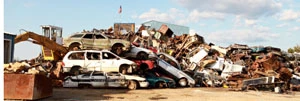
Click here to see the PDF of the 2010 Auto Shredder Map
The outright boom in auto shredding plant investment that occurred between the Recycling Today auto shredder lists of 2006 and 2008 may have been tempered in the ensuing two years, but it has by no means been snuffed.
The number of shredders jumped from 220 in 2006 to more than 250 in 2008 and has increased again—with nearly 290 shredding plants identified in 2010.
Research into the changes that have occurred in the past two years reveals that a higher percentage of plants on this year’s list are currently idle compared with 2008. Conversations with shredder operators also reveal that a majority of plants are running fewer days and hours than they were at the market peak from 2005 to early 2008.
But the growth in overall plant locations reveals another trend: Many scrap recyclers continue to regard owning a shredder as an important aspect of controlling their own destiny as a buyer and processor of scrap materials.
As Jason Shipman of Scrap’N, Farmington, Mo., says, “We are just a minnow in an ocean of whales and some sharks, just little bitty guys.”
Yet the company calculated that it could make a return on its shredder plant investment with what Shipman says was “an easily obtainable goal” of 1,800 tons per month. Subsequently, “our monthly average now is about 3,300 tons,” he says.
A LEANER DIET
Growth in the number of overall shredding plants would not seem to be a good fit with the market of the past two years.
Many shredding plant owners and managers have made adjustments to continue operating at reduced hours, but the overall drop in feedstock has likely contributed to the idling of other plants.
Larger companies with considerable capacity in multiple states have been among those idling some of their plants. PSC Metals reports that it is consolidating some of its shredding capacity in Tennessee, while Sims Metal Management has stopped shredding at two of its locations in New York.
Commodity prices that have stayed lofty despite the overall economic downturn have contributed to the ability of plants to stay viable while running few hours.
The addition of new shredding plants, especially in geographic regions where many new competitors have entered the market, is likely to force some operators to decide whether to re-invest or to cede the shredding market to others.
SPOTTING THE MUSHROOMS
The western U.S. is among the regions where newer shredder locations are being plotted on the map, as processors strive to provide shorter driving distances to potential customers.
Arizona’s four existing shredding plants will be joined by a fifth to be operated By Southwest Metals in Casa Grande.
In neighboring New Mexico, Albuquerque Metals Recycling operates the only shredding plant that was on the map in that state in 2008. But two projects are scheduled or underway that will triple the number of shredders in New Mexico.
Signs of overcapacity are seemingly appearing in Tennessee, where 16 shredding plants have been identified and listed, with two of these scheduled to be idled by the end of 2010.
Economic conditions and commodity prices remain critical factors determining whether dollars continue to be invested into shredding plants and their downstream systems.
Latest from Recycling Today
- Phoenix Technologies closes Ohio rPET facility
- EPA selects 2 governments in Pennsylvania to receive recycling, waste grants
- NWRA Florida Chapter announces 2025 Legislative Champion Awards
- Goldman Sachs Research: Copper prices to decline in 2026
- Tomra opens London RVM showroom
- Ball Corp. makes European investment
- Harbor Logistics adds business development executive
- Emerald Packaging replaces more than 1M pounds of virgin plastic





